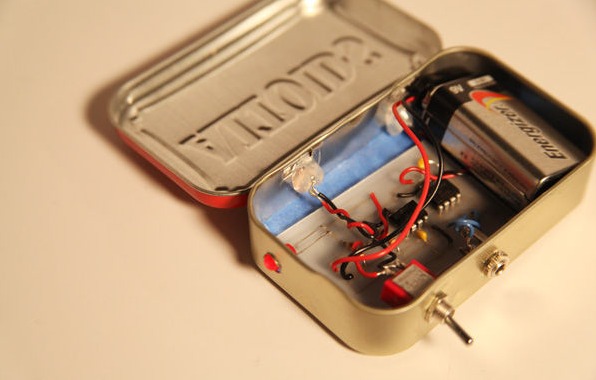Build a musical theremin
Build a simple theremin that plays changing pitches as your hand moves near an antenna, using a small speaker, wires, and safe low-voltage electronics.



Step-by-step guide to build a musical theremin
How to play a scale on the theremin | Carolina talks Theremin
Step 1
Clear a clean table and lay out the breadboard and all parts so you can reach them easily.
Step 2
Push the NE555 timer IC into the breadboard so it sits across the center gap with its flat side facing you.
Step 3
Use a jumper wire to connect pin 1 of the NE555 to the breadboard ground rail.
Step 4
Use a jumper wire to connect pin 8 of the NE555 to the breadboard +5V rail.
Step 5
Insert the 10k resistor so one end shares the same row as pin 8 and the other end shares the same row as pin 7.
Step 6
Place the 100k potentiometer so one outer leg is in the same row as pin 7 and the middle (wiper) leg is in the same row as pins 2 and 6.
Step 7
Put the 10nF capacitor with one leg in the row for pins 2 and 6 and the other leg in the ground rail.
Step 8
Plug the piezo buzzer's positive wire into the row for pin 3 and its negative wire into the ground rail.
Step 9
Attach a jumper wire from the pins 2/6 row to one end of the straightened paperclip so the paperclip acts as the antenna.
Step 10
With an adult, connect the USB power bank to the breadboard +5V and ground rails and turn the power bank on.
Step 11
Move your hand slowly toward and away from the antenna to hear the pitch change and turn the potentiometer to set the pitch range you like.
Step 12
Share a photo or short video of your finished theremin on DIY.org.
Final steps
You're almost there! Complete all the steps, bring your creation to life, post it, and conquer the challenge!


Help!?
What can I use if I can't find the NE555 IC or the piezo buzzer?
You can substitute any 555-compatible chip (for example LM555) for the NE555 and use a small 8Ω speaker or a larger piezo disc instead of the piezo buzzer, making sure the speaker/disc positive goes into the pin 3 row and its negative to the ground rail as in the steps.
Why do I hear no sound or no pitch change when I move my hand near the antenna?
If there's no sound or pitch change, check that the NE555 is seated across the breadboard gap with its flat side facing you, pins 1 and 8 are wired to ground and +5V respectively, the piezo positive is in the pin 3 row and its negative in ground, the 10nF capacitor has one leg in the pins 2/6 row and one in ground, and the jumper from pins 2/6 to the paperclip antenna is firmly connected.
How can I adapt this project for different age groups?
For ages 4–6 have an adult pre-insert the NE555 and major parts and let the child explore moving their hand near the paperclip antenna and decorating the setup, for ages 7–10 let them place labeled components and plug in jumper wires with supervision, and for 11+ let them assemble the full circuit from the instructions and experiment with changing the 100k potentiometer or swapping the piezo for a speaker.
How can we extend or personalize the theremin after finishing the basic build?
To enhance it, mount the breadboard in a decorated cardboard box, replace the piezo with a small speaker and add a simple NPN transistor amplifier plus another potentiometer for volume control between pin 3 and the speaker, then share a photo or video on DIY.org as suggested.
Watch videos on how to build a musical theremin
How to play Moog THEREMINI in 6 minutes! ✨👌🏼
Facts about electronics for kids
🎶 Clara Rockmore became the theremin's best-known virtuoso, adapting classical technique to this touch-free instrument.
👐 Classic theremins use two antennas: a vertical rod to control pitch and a loop or horizontal antenna to control volume.
🔬 Pitch changes happen because your hand alters the capacitance near the antenna, which shifts electronic oscillators.
🕰️ The instrument was invented around 1920 by Léon Theremin while he experimented with radio-frequency oscillators.
🎵 The theremin is played without touching it — you shape sound by moving your hands in the air near its antennas.
How to build a simple child-friendly musical theremin
Materials needed for a kid-safe theremin project
What ages is this theremin activity suitable for?
Safety tips for building and using a theremin with kids


One subscription, many ways to play and learn.
Only $6.99 after trial. No credit card required



